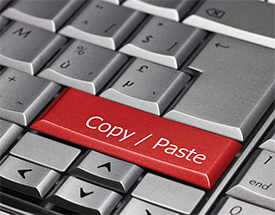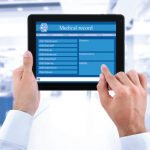
Image Credit: jurgenfr/SHUTTERSTOCK.COM
Case
You’ve been asked to see an inpatient for a rheumatologic consultation. After seeing the patient, you enter an initial consult note in the electronic medical record (EMR). The next day, when you write a follow-up note for this patient, you copy part of your assessment and plan from your prior note.
Soon after you sign your notes, you realize that your note has an error: It states that the patient had a total knee replacement on the left, when it was actually on the right. When you check other notes to confirm this, you find that one of the residents from a separate consulting team copied and pasted the majority of your history of present illness and past medical history verbatim, including the error regarding which knee had been replaced.
Discussion
The Health Information Technology for Economic and Clinical Health Act of 2009 (HITECH) has encouraged the use of EMRs. Further, in 2011, the U.S. government gave financial incentives to hospitals that established EMRs. Not only can EMRs improve coordination of care and decision making among providers, but they can also increase practice efficiency and savings, reduce medical errors and benefit clinical research.
On the other hand, the very nature of the electronic format gives rise to problems. EMRs allow physicians to copy and paste clinical documentation. Not only can physicians copy and paste from their own clinical notes (i.e., self-plagiarism), but they may also have the ability to cut and copy from other providers’ notes. This may be time saving for already time-starved physicians, but it may result in false documentation or the perpetuation of outdated or even incorrect clinical information. This misrepresentation of data may contribute to suboptimal care for patients or inappropriate billing.
Regardless of what guidelines or standards are developed in the future, it should be expected that all information that is ‘borrowed’ from other sources be carefully reviewed & edited for accuracy.
The use of plagiarism and self-plagiarism of medical documentation in EMRs is prevalent and rapidly increasing. Between 1993 and 2002, a study at the Veterans Administration (VA) found that 9% of notes reviewed in their EMRs had copied text, although copying has been reported as high as 20% in another VA study that examined only inpatient notes.1,2 Among the 44 notes placed in the highest risk category, labeled as “major potential risk of patient harm, fraud or tort claim exposure,” copying occurred most frequently in the exam (31 times) and the history of present illness (nine times). Over the last three years of the study period, the number of copy events almost tripled.1


